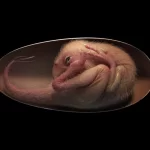Mutated tribe are the first known humans to genetically adapt to being underwater
In the depths of the Indonesian seas lives a tribe whose members hold an extraordinary secret—a genetic adaptation that allows them to dive deeper and longer than any other humans on Earth. The Bajau, often referred to as “sea nomads,” have spent centuries living in harmony with the ocean, their lives intertwined with the rhythm of the waves. Their remarkable ability to hold their breath for up to 13 minutes while diving to astonishing depths of 230 feet is not just a testament to human endurance, but also a possible evolutionary leap in human genetics.
This tribe’s incredible diving capability has intrigued scientists and researchers worldwide, leading to groundbreaking discoveries about human potential. Melissa A. Ilardo, a researcher from Cambridge University, has unearthed compelling evidence suggesting that the Bajau’s frequent and deep dives have driven genetic adaptations, particularly in their spleen size, which is pivotal for their underwater ventures. This adaptation could be the key to their almost superhuman ability to stay submerged for extended periods, challenging our understanding of human limits and opening up new vistas in genetic research and human physiology.
Exploring Medical Frontiers: Bajau Genetics and Human Health
As researchers delve deeper into the Bajau’s unique genetic makeup, intriguing questions arise about the potential applications of these findings in medical science. Could understanding the Bajau’s genetic adaptations lead to breakthroughs in respiratory or cardiovascular treatments? The enlarged spleen of the Bajau, crucial for storing and releasing oxygen-rich red blood cells, suggests new pathways for enhancing human tolerance to hypoxia (low oxygen environments). Such insights could revolutionize treatments for respiratory ailments, enhance recovery in sports medicine, or even improve surgical outcomes by managing blood oxygen levels more effectively.
Moreover, the Bajau’s lifestyle presents a living laboratory for studying human adaptation to extreme conditions. Their daily practices, which include spending up to 60 percent of their dive time submerged, challenge our existing knowledge of human physiological limits. By analyzing how their bodies adjust to such rigorous demands, scientists can explore new dimensions of human biology. This not only broadens our understanding of genetic plasticity but also illustrates the dynamic nature of human evolution, adapting over generations to environmental challenges.
The potential to harness and mimic these adaptations through genetic research or biomedical innovation opens a new frontier in enhancing human capability. As we stand on the brink of such scientific advancements, the Bajau tribe’s relationship with the sea not only captivates our imagination but also invites us to rethink the boundaries of human potential. Their lives, so deeply intertwined with the ocean, continue to inspire and challenge our understanding of what it means to be human in a world of diverse and extreme habitats.
Revisiting Human Evolution: The Bajau and Beyond
The genetic marvels of the Bajau tribe not only expand our understanding of human biology but also provoke a reevaluation of evolutionary theory itself. Traditional views of evolution are often grounded in slow, gradual changes over millennia. However, the rapid adaptation of the Bajau to underwater life suggests a more dynamic and responsive model of human evolution, one that reacts swiftly to environmental pressures. This has profound implications for evolutionary biology, suggesting that human populations can undergo significant physiological changes within relatively short periods when subjected to extreme environmental conditions.
The case of the Bajau tribe also underscores the importance of preserving indigenous cultures as reservoirs of invaluable genetic and ecological knowledge. Each community’s unique interaction with its environment provides critical insights into human resilience and adaptability. As modernization encroaches on these unique ways of life, there is an urgent need to document and study these communities before such living examples of human adaptability and ingenuity are lost.
Looking forward, the Bajau’s extraordinary abilities could inspire future explorations into genetic engineering and artificial adaptations for human survival in extreme environments, including outer space. As we venture beyond our terrestrial boundaries, the lessons learned from the Bajau could help us design better life support systems for astronauts, or even prepare humans for life on other planets. The Bajau not only challenge our understanding of what is physically and biologically possible but also light the way for future generations to thrive in environments once deemed uninhabitable.
The Ethical and Cultural Dimensions of Genetic Research
The fascination with the Bajau tribe’s extraordinary diving abilities is more than a scientific curiosity—it raises important ethical and cultural considerations. As we gain deeper insights into genetic adaptations like those found in the Bajau, we must also confront the implications of such knowledge. The prospect of using genetic information to enhance human abilities, while promising, involves complex ethical debates surrounding genetic privacy, consent, and the potential for misuse in the form of genetic discrimination or enhancement inequalities.
Moreover, the study of indigenous populations like the Bajau prompts a critical examination of how such research is conducted. There’s a pressing need to approach genetic studies with respect and sensitivity towards the cultural heritage and autonomy of indigenous communities. These communities are not just subjects of scientific inquiry but are custodians of traditions and knowledge systems that have been honed over centuries. Engaging with them in a manner that respects their values and contributions, ensuring that they benefit from the research, is essential for ethical science.
Additionally, this research touches on the broader issue of biodiversity and human adaptability. By understanding the genetic factors that enable the Bajau to excel in aquatic environments, scientists can contribute to broader conservation efforts, perhaps by advocating for the protection of marine habitats that are integral to the Bajau’s way of life. This aligns with a growing recognition of the role that indigenous practices can play in sustainable environmental management.
In the grand narrative of human evolution and adaptation, the story of the Bajau is a reminder of the diversity and complexity of human life. It challenges us to think about our future as a species—how we might adapt to changing environments and how our technological advancements could mimic or enhance natural adaptations. The journey into the genetics of the Bajau is not just about uncovering new knowledge; it’s about navigating the delicate balance between innovation and ethics, between understanding our past and responsibly shaping our future.
Fostering Global Collaboration and Future Research Opportunities
The insights gleaned from the Bajau tribe’s unique genetic adaptations open up vast opportunities for global scientific collaboration and research. By bringing together experts in genetics, evolutionary biology, anthropology, and environmental science, we can create a multidisciplinary approach
Understanding the Bajau’s Unique Adaptations
to studying human adaptability. Such collaborations can extend beyond the Bajau to other indigenous populations around the world, each with their own unique adaptations and insights into human survival and resilience.
One of the most exciting prospects is the development of international research initiatives that not only study genetic adaptations but also apply this knowledge to solve real-world problems. For instance, understanding how the Bajau tolerate low oxygen levels could help improve medical treatments for patients suffering from chronic lung diseases or help athletes recover more effectively from high-intensity performances. Additionally, insights into the Bajau’s ability to withstand great underwater pressures could influence the design of advanced diving equipment or submersible vehicles, enhancing human exploration of the oceans and beyond.
The future of such research could also involve the creation of global databases of human genetic adaptations, which could serve as invaluable resources for scientists worldwide. However, the success of these initiatives will hinge on their ability to operate ethically, ensuring that all communities involved are respected and that the benefits of research are shared equitably. This approach not only advances science but also fosters a greater understanding and appreciation of the interconnectedness of human cultures and the natural world.
Ultimately, the study of the Bajau tribe exemplifies how human curiosity, when paired with respect for diversity and ethical considerations, can lead to discoveries that enrich our understanding of the human species. As we continue to explore the genetic frontiers, let us also commit to the stewardship of the knowledge we gain, ensuring it serves to promote health, respect, and unity across the globe.
The Aquatic Superhumans: Embracing a Splash of Humor
While the genetic traits of the Bajau people offer profound insights into human evolution and potential, it’s worth diving into the lighter side of things as well. Imagine a world where we could all adapt Bajau-like abilities! Rush hour could see people swapping crowded subways for refreshing river routes, and snorkeling masks might become the new trendy accessory, not just for the fashion-forward but for anyone looking to take a shortcut through the local pond.
Jokes aside, the Bajau’s astonishing underwater feats are reminiscent of superhero abilities we often see in comic books and movies. There’s a delightful whimsy in thinking about how these real-life aquatic talents might fit into the fantastical worlds of our favorite maritime heroes. Perhaps in the next blockbuster, we’ll see a character inspired by the Bajau, equipped with natural diving gear and an unrivaled spleen capacity, battling villains under the sea or uncovering submerged treasures.
Moreover, incorporating a touch of humor and wonder into our discussion helps to humanize the science. It reminds us that behind every genetic study and biological statistic, there are stories of real people living extraordinary lives. The Bajau aren’t just subjects of scientific curiosity but are individuals with a deep connection to the ocean, a source of sustenance, mystery, and endless adventure. Their unique lifestyle not only challenges our understanding of human limits but also sparks our imagination about the possibilities of life harmoniously integrated with nature.
Key Takeaways: Understanding the Bajau’s Unique Adaptations
As we wrap up our exploration of the Bajau tribe’s remarkable underwater capabilities, here are some key points to remember about their genetic adaptations and the broader implications:
Enhanced Spleen Size: The Bajau have significantly larger spleens compared to average humans, which helps them store and release more oxygen-rich red blood cells during extended dives.
Genetic Adaptations: Research has identified specific genetic variants, such as the PDE10A gene, which are believed to contribute to their extraordinary diving abilities by influencing spleen size.
Potential Medical Applications: Insights from studying the Bajau could lead to advancements in medical treatments for respiratory and cardiovascular conditions by enhancing human tolerance to hypoxia.
Cultural Significance: The Bajau’s lifestyle emphasizes the importance of preserving indigenous cultures, which can offer unique insights into human adaptability and resilience.
Ethical Considerations: As with any genetic research, studies involving indigenous populations like the Bajau must be conducted with the utmost respect for their culture and consent, ensuring they benefit from the outcomes.
Inspiration for Future Technologies: Understanding the Bajaus’ adaptations could inspire innovations in diving technology and techniques, potentially expanding human capabilities in underwater exploration.
By keeping these points in mind, we can appreciate not only the scientific importance of the Bajau’s genetic traits but also the broader cultural, ethical, and practical implications of their unique relationship with the sea. This knowledge encourages us to think creatively about how human beings might continue to adapt to changing environments, enhancing our capabilities in harmonious ways with nature.
Embracing the Depths: Reflections on the Bajau and the Future of Human Adaptation
As we conclude our journey through the aquatic world of the Bajau, it’s clear that their unique genetic and cultural adaptations are more than just biological phenomena; they’re a testament to the incredible versatility and resilience of the human species. The Bajau not only challenge our understanding of physiological limits but also inspires us to reimagine the possibilities of human evolution in the face of environmental changes.
This exploration into the depths of the ocean and human genetics serves as a profound reminder of the interconnectedness of all life on Earth. It underscores the importance of respecting and preserving the diverse cultures and ecosystems that contribute to our collective knowledge and well-being. As we continue to push the boundaries of science and exploration, let us do so with a spirit of curiosity, responsibility, and inclusivity, ensuring that our advancements benefit all of humanity.
The story of the Bajau is a beacon for future explorations across various scientific fields and a call to think innovatively about our adaptability. Whether it’s adapting to life underwater or preparing for life on distant planets, the lessons we learn from the Bajau can inform and inspire future generations. As we dive into unknown territories, both literal and metaphorical, let’s carry with us the resilience, adaptability, and awe-inspiring capabilities of the Bajau, the true masters of the sea.












